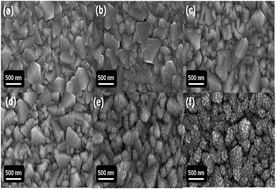Enhancement of solar cell efficiency using perovskite dyes deposited via a two-step process†
Abstract
This study examined the effect of different thick-compact-TiO2 blocking layers (c-TiO2) and mesoporous-TiO2 layers (m-TiO2) on the efficiency of perovskite cells. Anatase c-TiO2 layers with different thicknesses were in situ deposited onto a FTO/glass substrate at a temperature of 400 °C via nano-cluster deposition (NCD). The 80 nm-thick c-TiO2 layers were deposited with good step-coverage on the rough-FTO surface, and were in situ crystallized via an anatase phase. The perovskite cells with 80 nm-thick c-TiO2 and 600 nm-thick-m-TiO2 layers showed the highest photovoltaic parameters: JSC of 21.0 mA cm−2, VOC of 0.89 V, FF of 62%, and efficiency (η) of 11.5%. For enhancement of the cell efficiency, solar cells with bi-layer perovskite dyes were deposited via a two-step process onto the m-TiO2 layer (200 nm)/TiO2 blocking layers (80 nm) and showed VOC and FF values of approximately 1.06 and 64%, respectively, with a maximum photo-conversion efficiency of approximately 14.2%.


 Please wait while we load your content...
Please wait while we load your content...